Managing Communications: Decision Making and Stakeholder Involvement
VerifiedAdded on 2020/01/28
|17
|5339
|255
Report
AI Summary
This report delves into the critical aspects of managing communications within an organizational framework. It begins with an assessment of the necessity of information and knowledge, evaluating decisional responsibilities, the importance of information in effective decision-making, various information sources, and recommendations for improvement. The report then explores strategies for stakeholder involvement, identifying stakeholders, establishing contact, and integrating them into the decision-making process. Further, it examines communication processes within organizations, suggesting improvements for better system integration and personal communication development. Finally, it addresses the storage, collection, formatting, and dissemination of information and knowledge, proposing changes to enhance these processes and improve access to information systems. The report highlights the importance of effective communication for organizational sustainability and competitive advantage.
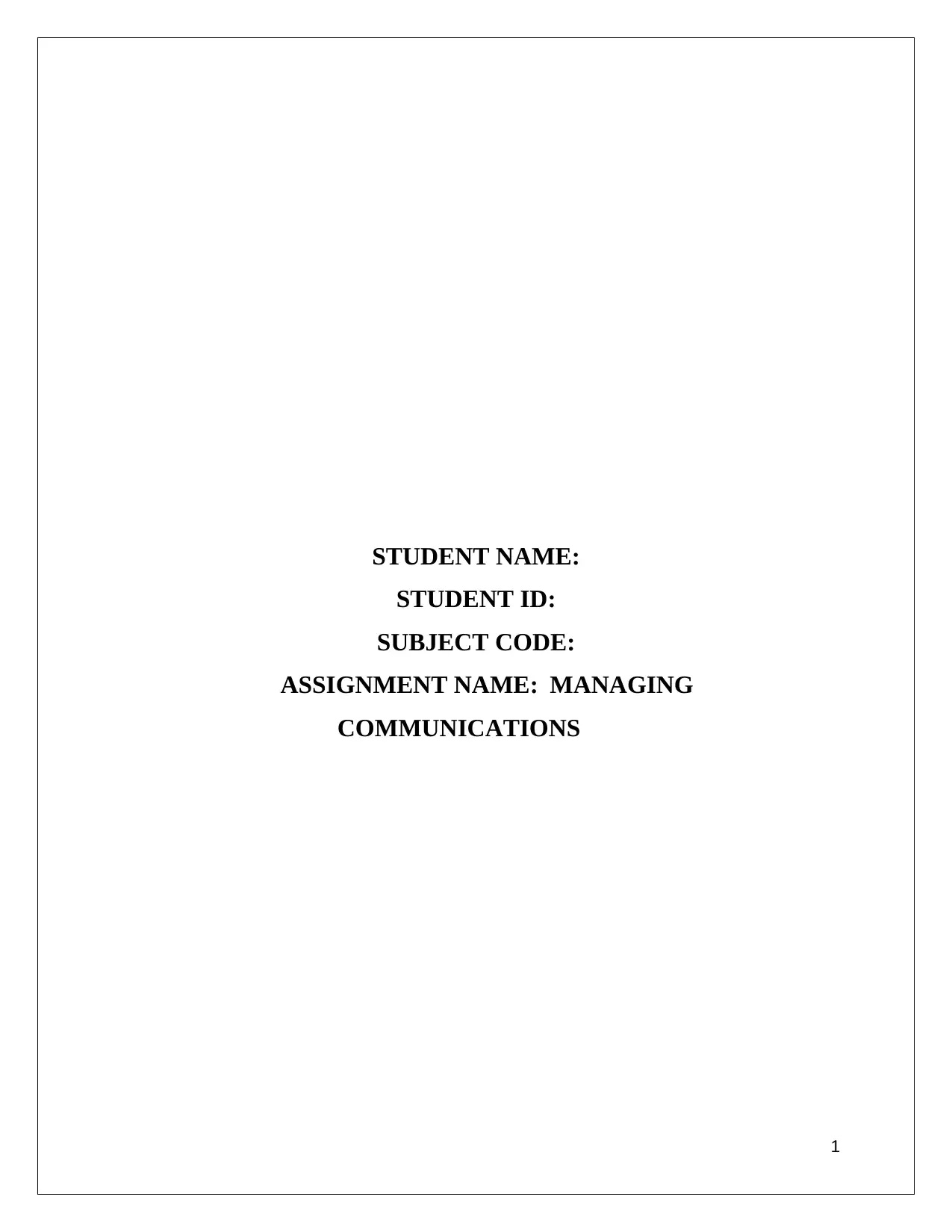
STUDENT NAME:
STUDENT ID:
SUBJECT CODE:
ASSIGNMENT NAME: MANAGING
COMMUNICATIONS
1
STUDENT ID:
SUBJECT CODE:
ASSIGNMENT NAME: MANAGING
COMMUNICATIONS
1
Paraphrase This Document
Need a fresh take? Get an instant paraphrase of this document with our AI Paraphraser
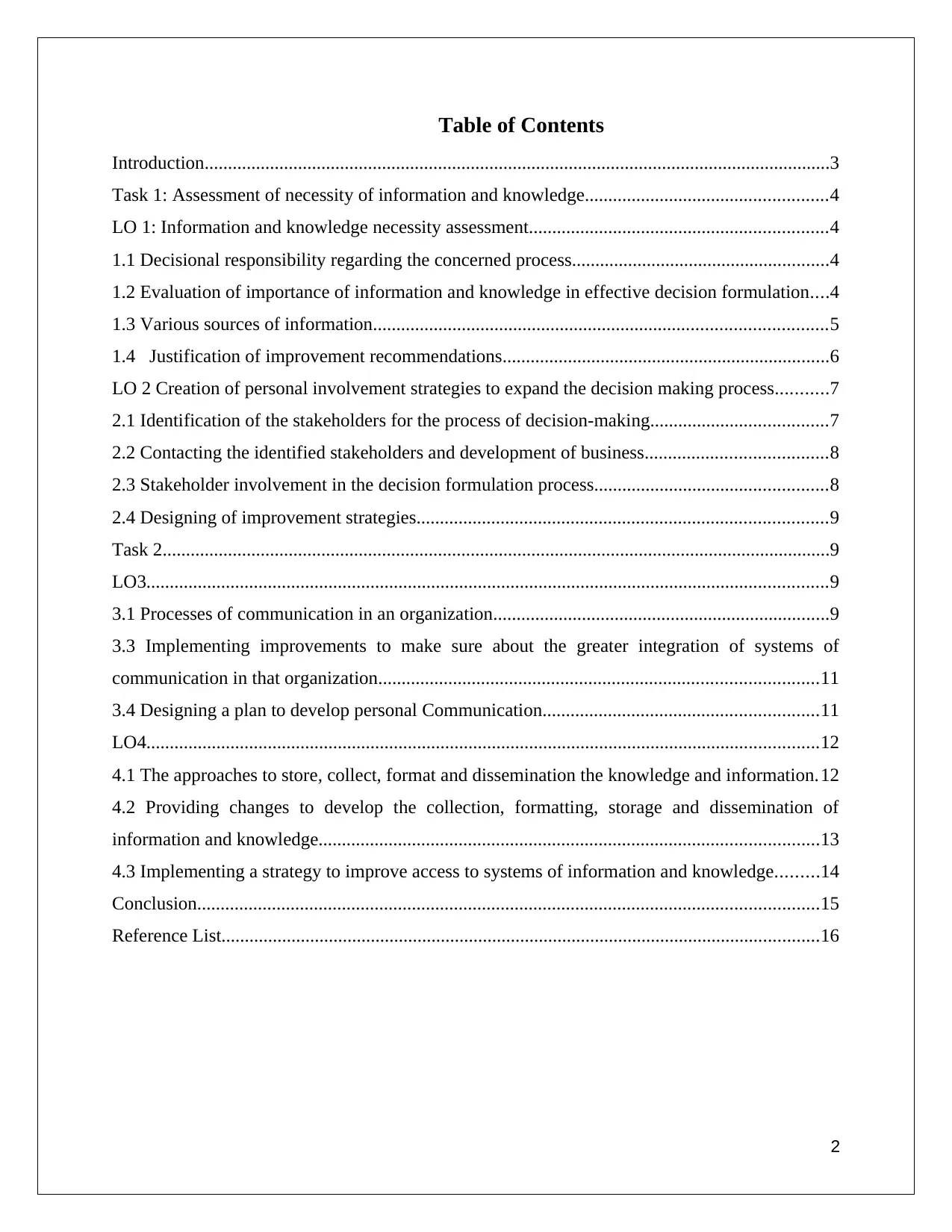
Table of Contents
Introduction......................................................................................................................................3
Task 1: Assessment of necessity of information and knowledge....................................................4
LO 1: Information and knowledge necessity assessment................................................................4
1.1 Decisional responsibility regarding the concerned process.......................................................4
1.2 Evaluation of importance of information and knowledge in effective decision formulation....4
1.3 Various sources of information.................................................................................................5
1.4 Justification of improvement recommendations......................................................................6
LO 2 Creation of personal involvement strategies to expand the decision making process...........7
2.1 Identification of the stakeholders for the process of decision-making......................................7
2.2 Contacting the identified stakeholders and development of business.......................................8
2.3 Stakeholder involvement in the decision formulation process..................................................8
2.4 Designing of improvement strategies........................................................................................9
Task 2...............................................................................................................................................9
LO3..................................................................................................................................................9
3.1 Processes of communication in an organization........................................................................9
3.3 Implementing improvements to make sure about the greater integration of systems of
communication in that organization..............................................................................................11
3.4 Designing a plan to develop personal Communication...........................................................11
LO4................................................................................................................................................12
4.1 The approaches to store, collect, format and dissemination the knowledge and information.12
4.2 Providing changes to develop the collection, formatting, storage and dissemination of
information and knowledge...........................................................................................................13
4.3 Implementing a strategy to improve access to systems of information and knowledge.........14
Conclusion.....................................................................................................................................15
Reference List................................................................................................................................16
2
Introduction......................................................................................................................................3
Task 1: Assessment of necessity of information and knowledge....................................................4
LO 1: Information and knowledge necessity assessment................................................................4
1.1 Decisional responsibility regarding the concerned process.......................................................4
1.2 Evaluation of importance of information and knowledge in effective decision formulation....4
1.3 Various sources of information.................................................................................................5
1.4 Justification of improvement recommendations......................................................................6
LO 2 Creation of personal involvement strategies to expand the decision making process...........7
2.1 Identification of the stakeholders for the process of decision-making......................................7
2.2 Contacting the identified stakeholders and development of business.......................................8
2.3 Stakeholder involvement in the decision formulation process..................................................8
2.4 Designing of improvement strategies........................................................................................9
Task 2...............................................................................................................................................9
LO3..................................................................................................................................................9
3.1 Processes of communication in an organization........................................................................9
3.3 Implementing improvements to make sure about the greater integration of systems of
communication in that organization..............................................................................................11
3.4 Designing a plan to develop personal Communication...........................................................11
LO4................................................................................................................................................12
4.1 The approaches to store, collect, format and dissemination the knowledge and information.12
4.2 Providing changes to develop the collection, formatting, storage and dissemination of
information and knowledge...........................................................................................................13
4.3 Implementing a strategy to improve access to systems of information and knowledge.........14
Conclusion.....................................................................................................................................15
Reference List................................................................................................................................16
2
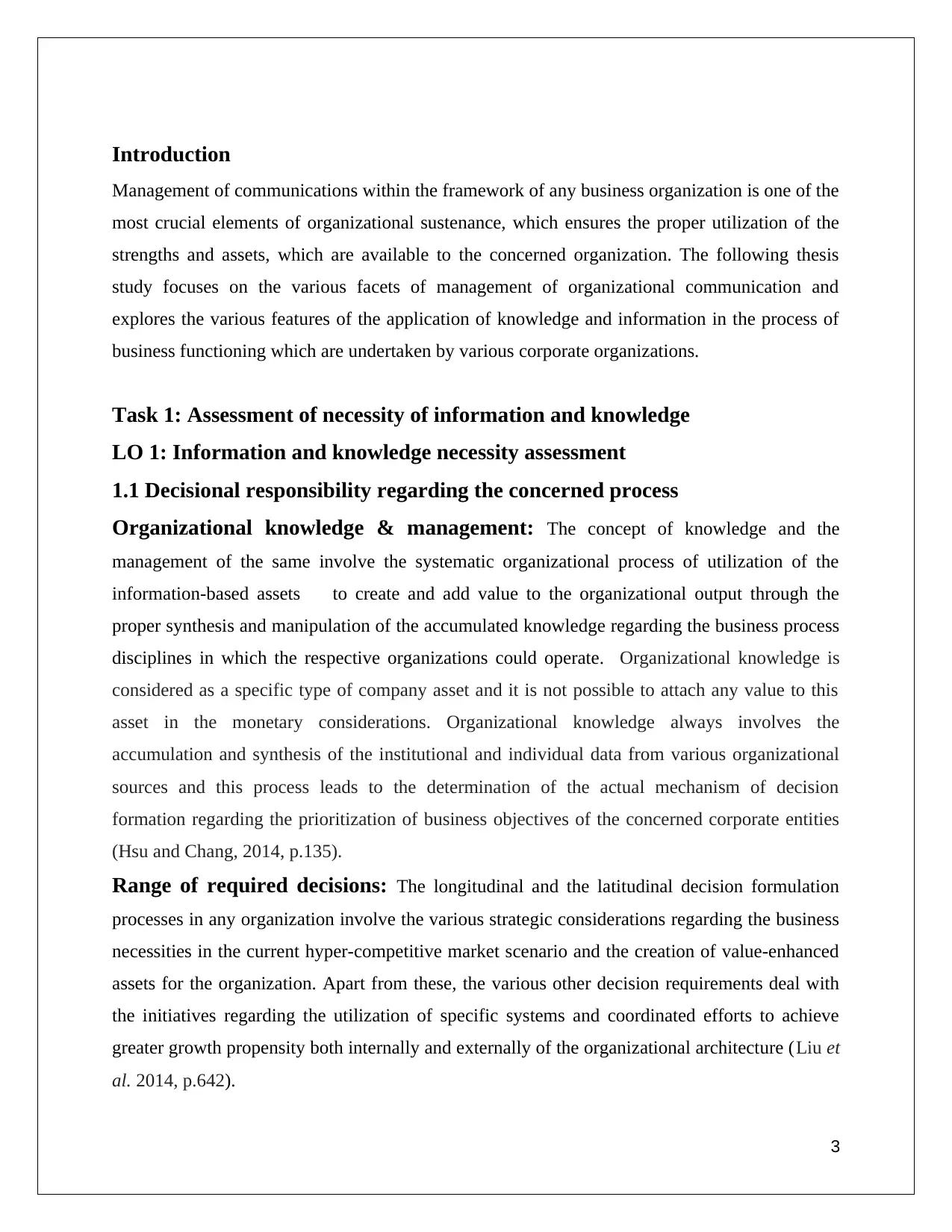
Introduction
Management of communications within the framework of any business organization is one of the
most crucial elements of organizational sustenance, which ensures the proper utilization of the
strengths and assets, which are available to the concerned organization. The following thesis
study focuses on the various facets of management of organizational communication and
explores the various features of the application of knowledge and information in the process of
business functioning which are undertaken by various corporate organizations.
Task 1: Assessment of necessity of information and knowledge
LO 1: Information and knowledge necessity assessment
1.1 Decisional responsibility regarding the concerned process
Organizational knowledge & management: The concept of knowledge and the
management of the same involve the systematic organizational process of utilization of the
information-based assets to create and add value to the organizational output through the
proper synthesis and manipulation of the accumulated knowledge regarding the business process
disciplines in which the respective organizations could operate. Organizational knowledge is
considered as a specific type of company asset and it is not possible to attach any value to this
asset in the monetary considerations. Organizational knowledge always involves the
accumulation and synthesis of the institutional and individual data from various organizational
sources and this process leads to the determination of the actual mechanism of decision
formation regarding the prioritization of business objectives of the concerned corporate entities
(Hsu and Chang, 2014, p.135).
Range of required decisions: The longitudinal and the latitudinal decision formulation
processes in any organization involve the various strategic considerations regarding the business
necessities in the current hyper-competitive market scenario and the creation of value-enhanced
assets for the organization. Apart from these, the various other decision requirements deal with
the initiatives regarding the utilization of specific systems and coordinated efforts to achieve
greater growth propensity both internally and externally of the organizational architecture (Liu et
al. 2014, p.642).
3
Management of communications within the framework of any business organization is one of the
most crucial elements of organizational sustenance, which ensures the proper utilization of the
strengths and assets, which are available to the concerned organization. The following thesis
study focuses on the various facets of management of organizational communication and
explores the various features of the application of knowledge and information in the process of
business functioning which are undertaken by various corporate organizations.
Task 1: Assessment of necessity of information and knowledge
LO 1: Information and knowledge necessity assessment
1.1 Decisional responsibility regarding the concerned process
Organizational knowledge & management: The concept of knowledge and the
management of the same involve the systematic organizational process of utilization of the
information-based assets to create and add value to the organizational output through the
proper synthesis and manipulation of the accumulated knowledge regarding the business process
disciplines in which the respective organizations could operate. Organizational knowledge is
considered as a specific type of company asset and it is not possible to attach any value to this
asset in the monetary considerations. Organizational knowledge always involves the
accumulation and synthesis of the institutional and individual data from various organizational
sources and this process leads to the determination of the actual mechanism of decision
formation regarding the prioritization of business objectives of the concerned corporate entities
(Hsu and Chang, 2014, p.135).
Range of required decisions: The longitudinal and the latitudinal decision formulation
processes in any organization involve the various strategic considerations regarding the business
necessities in the current hyper-competitive market scenario and the creation of value-enhanced
assets for the organization. Apart from these, the various other decision requirements deal with
the initiatives regarding the utilization of specific systems and coordinated efforts to achieve
greater growth propensity both internally and externally of the organizational architecture (Liu et
al. 2014, p.642).
3
⊘ This is a preview!⊘
Do you want full access?
Subscribe today to unlock all pages.

Trusted by 1+ million students worldwide
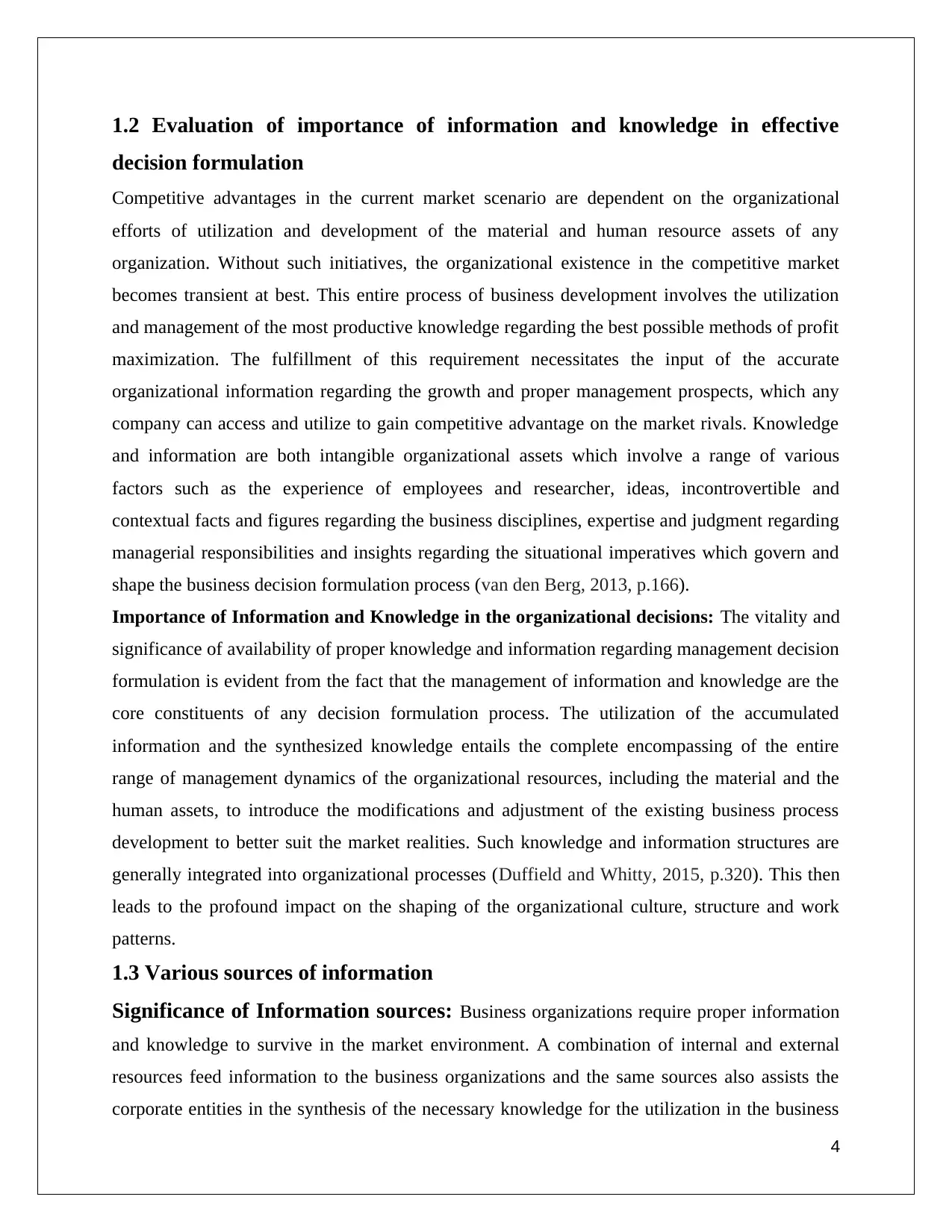
1.2 Evaluation of importance of information and knowledge in effective
decision formulation
Competitive advantages in the current market scenario are dependent on the organizational
efforts of utilization and development of the material and human resource assets of any
organization. Without such initiatives, the organizational existence in the competitive market
becomes transient at best. This entire process of business development involves the utilization
and management of the most productive knowledge regarding the best possible methods of profit
maximization. The fulfillment of this requirement necessitates the input of the accurate
organizational information regarding the growth and proper management prospects, which any
company can access and utilize to gain competitive advantage on the market rivals. Knowledge
and information are both intangible organizational assets which involve a range of various
factors such as the experience of employees and researcher, ideas, incontrovertible and
contextual facts and figures regarding the business disciplines, expertise and judgment regarding
managerial responsibilities and insights regarding the situational imperatives which govern and
shape the business decision formulation process (van den Berg, 2013, p.166).
Importance of Information and Knowledge in the organizational decisions: The vitality and
significance of availability of proper knowledge and information regarding management decision
formulation is evident from the fact that the management of information and knowledge are the
core constituents of any decision formulation process. The utilization of the accumulated
information and the synthesized knowledge entails the complete encompassing of the entire
range of management dynamics of the organizational resources, including the material and the
human assets, to introduce the modifications and adjustment of the existing business process
development to better suit the market realities. Such knowledge and information structures are
generally integrated into organizational processes (Duffield and Whitty, 2015, p.320). This then
leads to the profound impact on the shaping of the organizational culture, structure and work
patterns.
1.3 Various sources of information
Significance of Information sources: Business organizations require proper information
and knowledge to survive in the market environment. A combination of internal and external
resources feed information to the business organizations and the same sources also assists the
corporate entities in the synthesis of the necessary knowledge for the utilization in the business
4
decision formulation
Competitive advantages in the current market scenario are dependent on the organizational
efforts of utilization and development of the material and human resource assets of any
organization. Without such initiatives, the organizational existence in the competitive market
becomes transient at best. This entire process of business development involves the utilization
and management of the most productive knowledge regarding the best possible methods of profit
maximization. The fulfillment of this requirement necessitates the input of the accurate
organizational information regarding the growth and proper management prospects, which any
company can access and utilize to gain competitive advantage on the market rivals. Knowledge
and information are both intangible organizational assets which involve a range of various
factors such as the experience of employees and researcher, ideas, incontrovertible and
contextual facts and figures regarding the business disciplines, expertise and judgment regarding
managerial responsibilities and insights regarding the situational imperatives which govern and
shape the business decision formulation process (van den Berg, 2013, p.166).
Importance of Information and Knowledge in the organizational decisions: The vitality and
significance of availability of proper knowledge and information regarding management decision
formulation is evident from the fact that the management of information and knowledge are the
core constituents of any decision formulation process. The utilization of the accumulated
information and the synthesized knowledge entails the complete encompassing of the entire
range of management dynamics of the organizational resources, including the material and the
human assets, to introduce the modifications and adjustment of the existing business process
development to better suit the market realities. Such knowledge and information structures are
generally integrated into organizational processes (Duffield and Whitty, 2015, p.320). This then
leads to the profound impact on the shaping of the organizational culture, structure and work
patterns.
1.3 Various sources of information
Significance of Information sources: Business organizations require proper information
and knowledge to survive in the market environment. A combination of internal and external
resources feed information to the business organizations and the same sources also assists the
corporate entities in the synthesis of the necessary knowledge for the utilization in the business
4
Paraphrase This Document
Need a fresh take? Get an instant paraphrase of this document with our AI Paraphraser
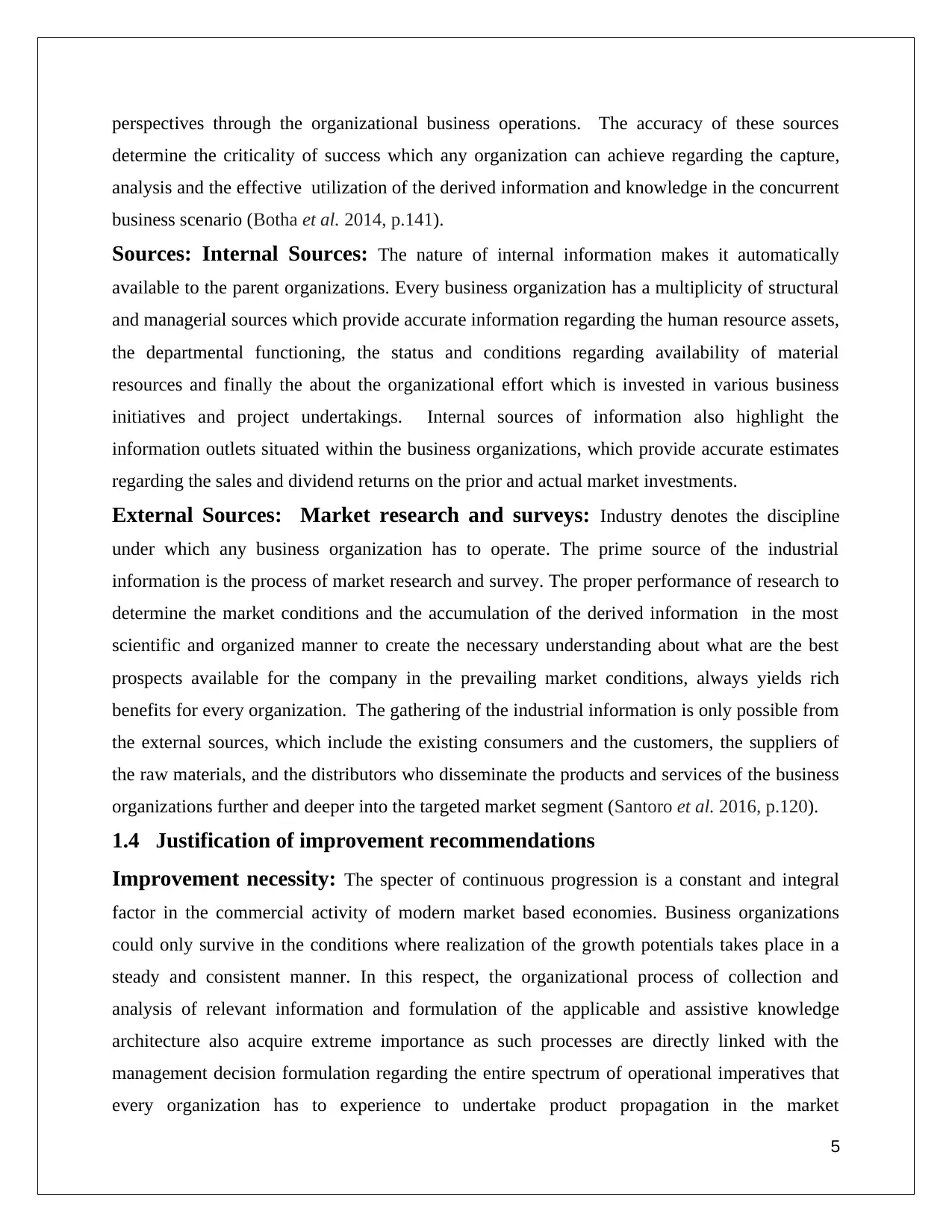
perspectives through the organizational business operations. The accuracy of these sources
determine the criticality of success which any organization can achieve regarding the capture,
analysis and the effective utilization of the derived information and knowledge in the concurrent
business scenario (Botha et al. 2014, p.141).
Sources: Internal Sources: The nature of internal information makes it automatically
available to the parent organizations. Every business organization has a multiplicity of structural
and managerial sources which provide accurate information regarding the human resource assets,
the departmental functioning, the status and conditions regarding availability of material
resources and finally the about the organizational effort which is invested in various business
initiatives and project undertakings. Internal sources of information also highlight the
information outlets situated within the business organizations, which provide accurate estimates
regarding the sales and dividend returns on the prior and actual market investments.
External Sources: Market research and surveys: Industry denotes the discipline
under which any business organization has to operate. The prime source of the industrial
information is the process of market research and survey. The proper performance of research to
determine the market conditions and the accumulation of the derived information in the most
scientific and organized manner to create the necessary understanding about what are the best
prospects available for the company in the prevailing market conditions, always yields rich
benefits for every organization. The gathering of the industrial information is only possible from
the external sources, which include the existing consumers and the customers, the suppliers of
the raw materials, and the distributors who disseminate the products and services of the business
organizations further and deeper into the targeted market segment (Santoro et al. 2016, p.120).
1.4 Justification of improvement recommendations
Improvement necessity: The specter of continuous progression is a constant and integral
factor in the commercial activity of modern market based economies. Business organizations
could only survive in the conditions where realization of the growth potentials takes place in a
steady and consistent manner. In this respect, the organizational process of collection and
analysis of relevant information and formulation of the applicable and assistive knowledge
architecture also acquire extreme importance as such processes are directly linked with the
management decision formulation regarding the entire spectrum of operational imperatives that
every organization has to experience to undertake product propagation in the market
5
determine the criticality of success which any organization can achieve regarding the capture,
analysis and the effective utilization of the derived information and knowledge in the concurrent
business scenario (Botha et al. 2014, p.141).
Sources: Internal Sources: The nature of internal information makes it automatically
available to the parent organizations. Every business organization has a multiplicity of structural
and managerial sources which provide accurate information regarding the human resource assets,
the departmental functioning, the status and conditions regarding availability of material
resources and finally the about the organizational effort which is invested in various business
initiatives and project undertakings. Internal sources of information also highlight the
information outlets situated within the business organizations, which provide accurate estimates
regarding the sales and dividend returns on the prior and actual market investments.
External Sources: Market research and surveys: Industry denotes the discipline
under which any business organization has to operate. The prime source of the industrial
information is the process of market research and survey. The proper performance of research to
determine the market conditions and the accumulation of the derived information in the most
scientific and organized manner to create the necessary understanding about what are the best
prospects available for the company in the prevailing market conditions, always yields rich
benefits for every organization. The gathering of the industrial information is only possible from
the external sources, which include the existing consumers and the customers, the suppliers of
the raw materials, and the distributors who disseminate the products and services of the business
organizations further and deeper into the targeted market segment (Santoro et al. 2016, p.120).
1.4 Justification of improvement recommendations
Improvement necessity: The specter of continuous progression is a constant and integral
factor in the commercial activity of modern market based economies. Business organizations
could only survive in the conditions where realization of the growth potentials takes place in a
steady and consistent manner. In this respect, the organizational process of collection and
analysis of relevant information and formulation of the applicable and assistive knowledge
architecture also acquire extreme importance as such processes are directly linked with the
management decision formulation regarding the entire spectrum of operational imperatives that
every organization has to experience to undertake product propagation in the market
5
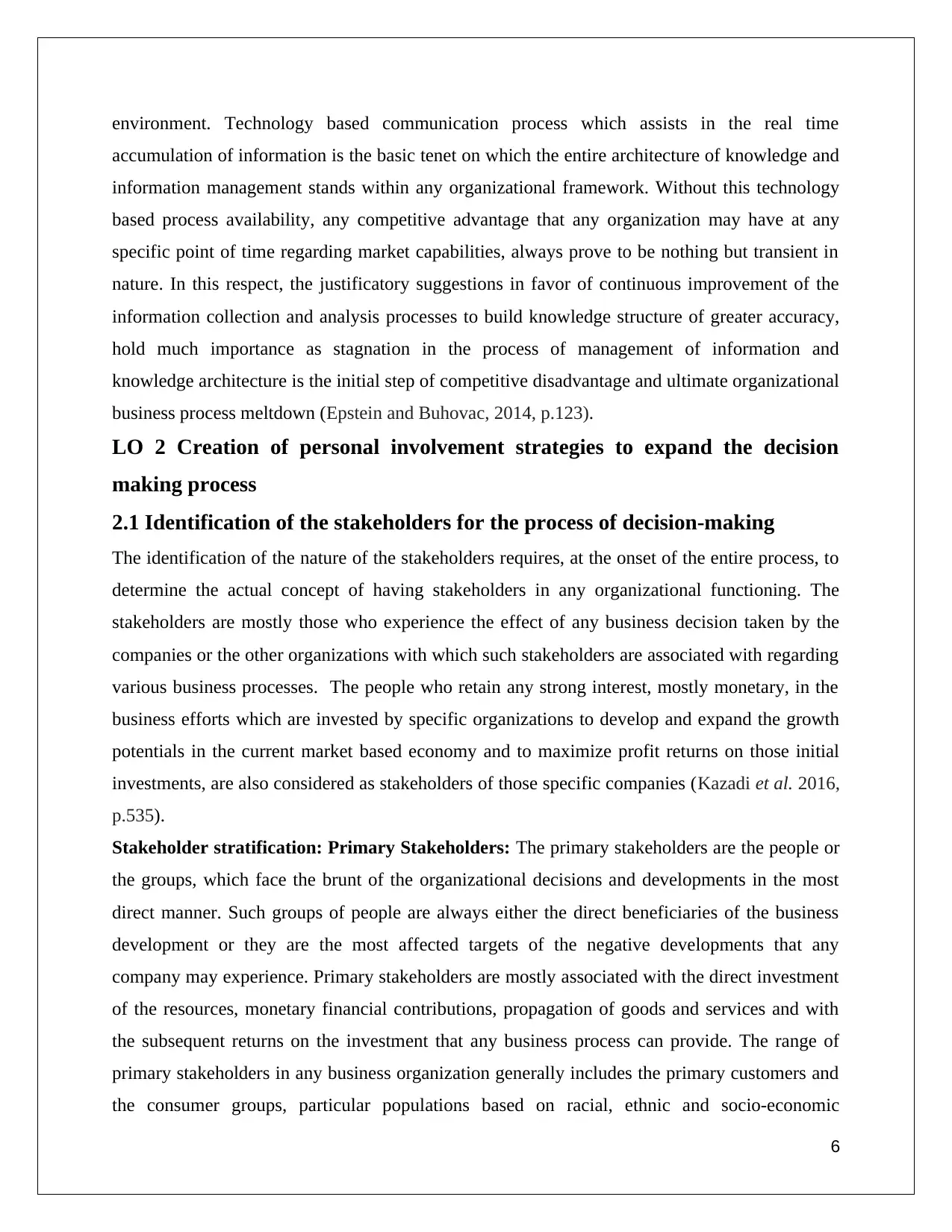
environment. Technology based communication process which assists in the real time
accumulation of information is the basic tenet on which the entire architecture of knowledge and
information management stands within any organizational framework. Without this technology
based process availability, any competitive advantage that any organization may have at any
specific point of time regarding market capabilities, always prove to be nothing but transient in
nature. In this respect, the justificatory suggestions in favor of continuous improvement of the
information collection and analysis processes to build knowledge structure of greater accuracy,
hold much importance as stagnation in the process of management of information and
knowledge architecture is the initial step of competitive disadvantage and ultimate organizational
business process meltdown (Epstein and Buhovac, 2014, p.123).
LO 2 Creation of personal involvement strategies to expand the decision
making process
2.1 Identification of the stakeholders for the process of decision-making
The identification of the nature of the stakeholders requires, at the onset of the entire process, to
determine the actual concept of having stakeholders in any organizational functioning. The
stakeholders are mostly those who experience the effect of any business decision taken by the
companies or the other organizations with which such stakeholders are associated with regarding
various business processes. The people who retain any strong interest, mostly monetary, in the
business efforts which are invested by specific organizations to develop and expand the growth
potentials in the current market based economy and to maximize profit returns on those initial
investments, are also considered as stakeholders of those specific companies (Kazadi et al. 2016,
p.535).
Stakeholder stratification: Primary Stakeholders: The primary stakeholders are the people or
the groups, which face the brunt of the organizational decisions and developments in the most
direct manner. Such groups of people are always either the direct beneficiaries of the business
development or they are the most affected targets of the negative developments that any
company may experience. Primary stakeholders are mostly associated with the direct investment
of the resources, monetary financial contributions, propagation of goods and services and with
the subsequent returns on the investment that any business process can provide. The range of
primary stakeholders in any business organization generally includes the primary customers and
the consumer groups, particular populations based on racial, ethnic and socio-economic
6
accumulation of information is the basic tenet on which the entire architecture of knowledge and
information management stands within any organizational framework. Without this technology
based process availability, any competitive advantage that any organization may have at any
specific point of time regarding market capabilities, always prove to be nothing but transient in
nature. In this respect, the justificatory suggestions in favor of continuous improvement of the
information collection and analysis processes to build knowledge structure of greater accuracy,
hold much importance as stagnation in the process of management of information and
knowledge architecture is the initial step of competitive disadvantage and ultimate organizational
business process meltdown (Epstein and Buhovac, 2014, p.123).
LO 2 Creation of personal involvement strategies to expand the decision
making process
2.1 Identification of the stakeholders for the process of decision-making
The identification of the nature of the stakeholders requires, at the onset of the entire process, to
determine the actual concept of having stakeholders in any organizational functioning. The
stakeholders are mostly those who experience the effect of any business decision taken by the
companies or the other organizations with which such stakeholders are associated with regarding
various business processes. The people who retain any strong interest, mostly monetary, in the
business efforts which are invested by specific organizations to develop and expand the growth
potentials in the current market based economy and to maximize profit returns on those initial
investments, are also considered as stakeholders of those specific companies (Kazadi et al. 2016,
p.535).
Stakeholder stratification: Primary Stakeholders: The primary stakeholders are the people or
the groups, which face the brunt of the organizational decisions and developments in the most
direct manner. Such groups of people are always either the direct beneficiaries of the business
development or they are the most affected targets of the negative developments that any
company may experience. Primary stakeholders are mostly associated with the direct investment
of the resources, monetary financial contributions, propagation of goods and services and with
the subsequent returns on the investment that any business process can provide. The range of
primary stakeholders in any business organization generally includes the primary customers and
the consumer groups, particular populations based on racial, ethnic and socio-economic
6
⊘ This is a preview!⊘
Do you want full access?
Subscribe today to unlock all pages.

Trusted by 1+ million students worldwide
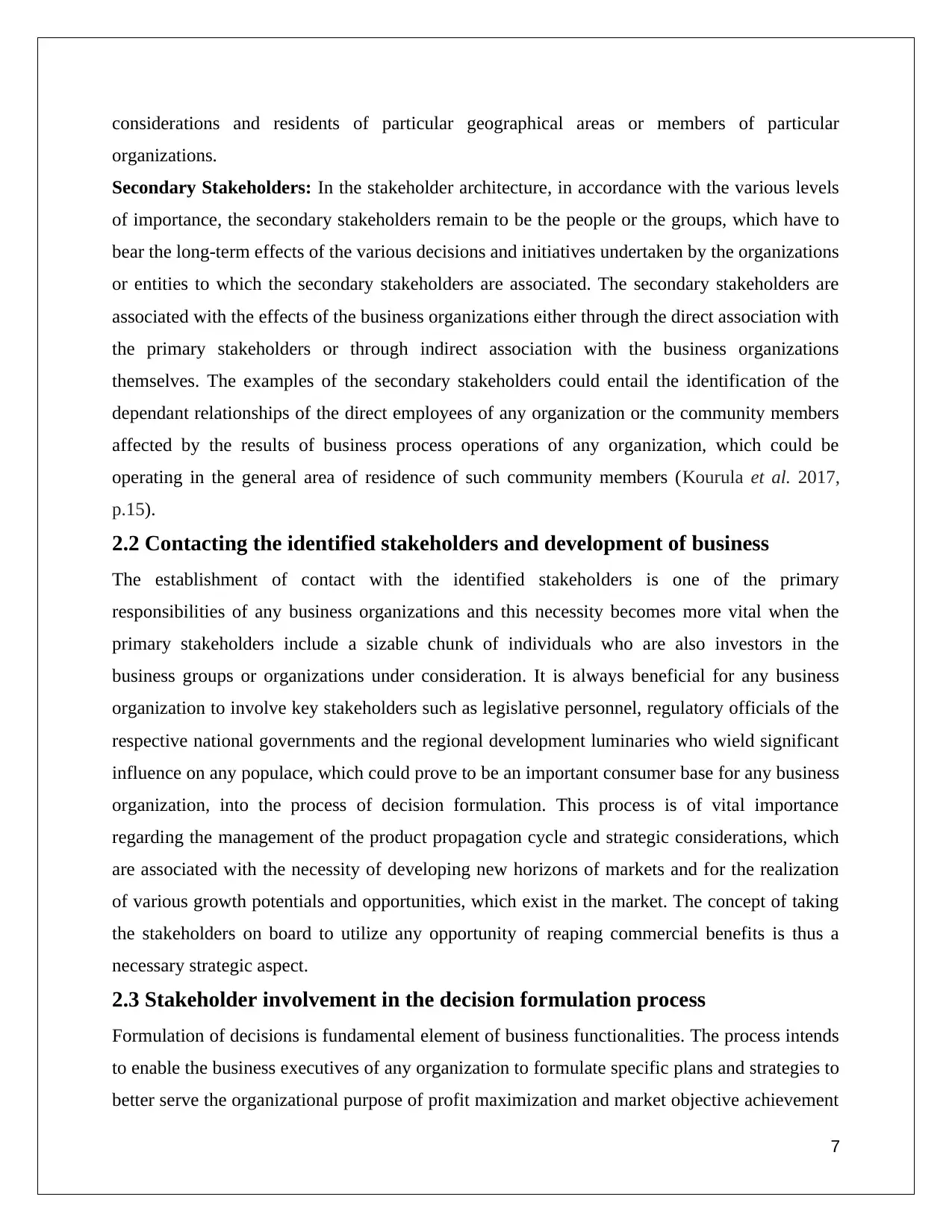
considerations and residents of particular geographical areas or members of particular
organizations.
Secondary Stakeholders: In the stakeholder architecture, in accordance with the various levels
of importance, the secondary stakeholders remain to be the people or the groups, which have to
bear the long-term effects of the various decisions and initiatives undertaken by the organizations
or entities to which the secondary stakeholders are associated. The secondary stakeholders are
associated with the effects of the business organizations either through the direct association with
the primary stakeholders or through indirect association with the business organizations
themselves. The examples of the secondary stakeholders could entail the identification of the
dependant relationships of the direct employees of any organization or the community members
affected by the results of business process operations of any organization, which could be
operating in the general area of residence of such community members (Kourula et al. 2017,
p.15).
2.2 Contacting the identified stakeholders and development of business
The establishment of contact with the identified stakeholders is one of the primary
responsibilities of any business organizations and this necessity becomes more vital when the
primary stakeholders include a sizable chunk of individuals who are also investors in the
business groups or organizations under consideration. It is always beneficial for any business
organization to involve key stakeholders such as legislative personnel, regulatory officials of the
respective national governments and the regional development luminaries who wield significant
influence on any populace, which could prove to be an important consumer base for any business
organization, into the process of decision formulation. This process is of vital importance
regarding the management of the product propagation cycle and strategic considerations, which
are associated with the necessity of developing new horizons of markets and for the realization
of various growth potentials and opportunities, which exist in the market. The concept of taking
the stakeholders on board to utilize any opportunity of reaping commercial benefits is thus a
necessary strategic aspect.
2.3 Stakeholder involvement in the decision formulation process
Formulation of decisions is fundamental element of business functionalities. The process intends
to enable the business executives of any organization to formulate specific plans and strategies to
better serve the organizational purpose of profit maximization and market objective achievement
7
organizations.
Secondary Stakeholders: In the stakeholder architecture, in accordance with the various levels
of importance, the secondary stakeholders remain to be the people or the groups, which have to
bear the long-term effects of the various decisions and initiatives undertaken by the organizations
or entities to which the secondary stakeholders are associated. The secondary stakeholders are
associated with the effects of the business organizations either through the direct association with
the primary stakeholders or through indirect association with the business organizations
themselves. The examples of the secondary stakeholders could entail the identification of the
dependant relationships of the direct employees of any organization or the community members
affected by the results of business process operations of any organization, which could be
operating in the general area of residence of such community members (Kourula et al. 2017,
p.15).
2.2 Contacting the identified stakeholders and development of business
The establishment of contact with the identified stakeholders is one of the primary
responsibilities of any business organizations and this necessity becomes more vital when the
primary stakeholders include a sizable chunk of individuals who are also investors in the
business groups or organizations under consideration. It is always beneficial for any business
organization to involve key stakeholders such as legislative personnel, regulatory officials of the
respective national governments and the regional development luminaries who wield significant
influence on any populace, which could prove to be an important consumer base for any business
organization, into the process of decision formulation. This process is of vital importance
regarding the management of the product propagation cycle and strategic considerations, which
are associated with the necessity of developing new horizons of markets and for the realization
of various growth potentials and opportunities, which exist in the market. The concept of taking
the stakeholders on board to utilize any opportunity of reaping commercial benefits is thus a
necessary strategic aspect.
2.3 Stakeholder involvement in the decision formulation process
Formulation of decisions is fundamental element of business functionalities. The process intends
to enable the business executives of any organization to formulate specific plans and strategies to
better serve the organizational purpose of profit maximization and market objective achievement
7
Paraphrase This Document
Need a fresh take? Get an instant paraphrase of this document with our AI Paraphraser
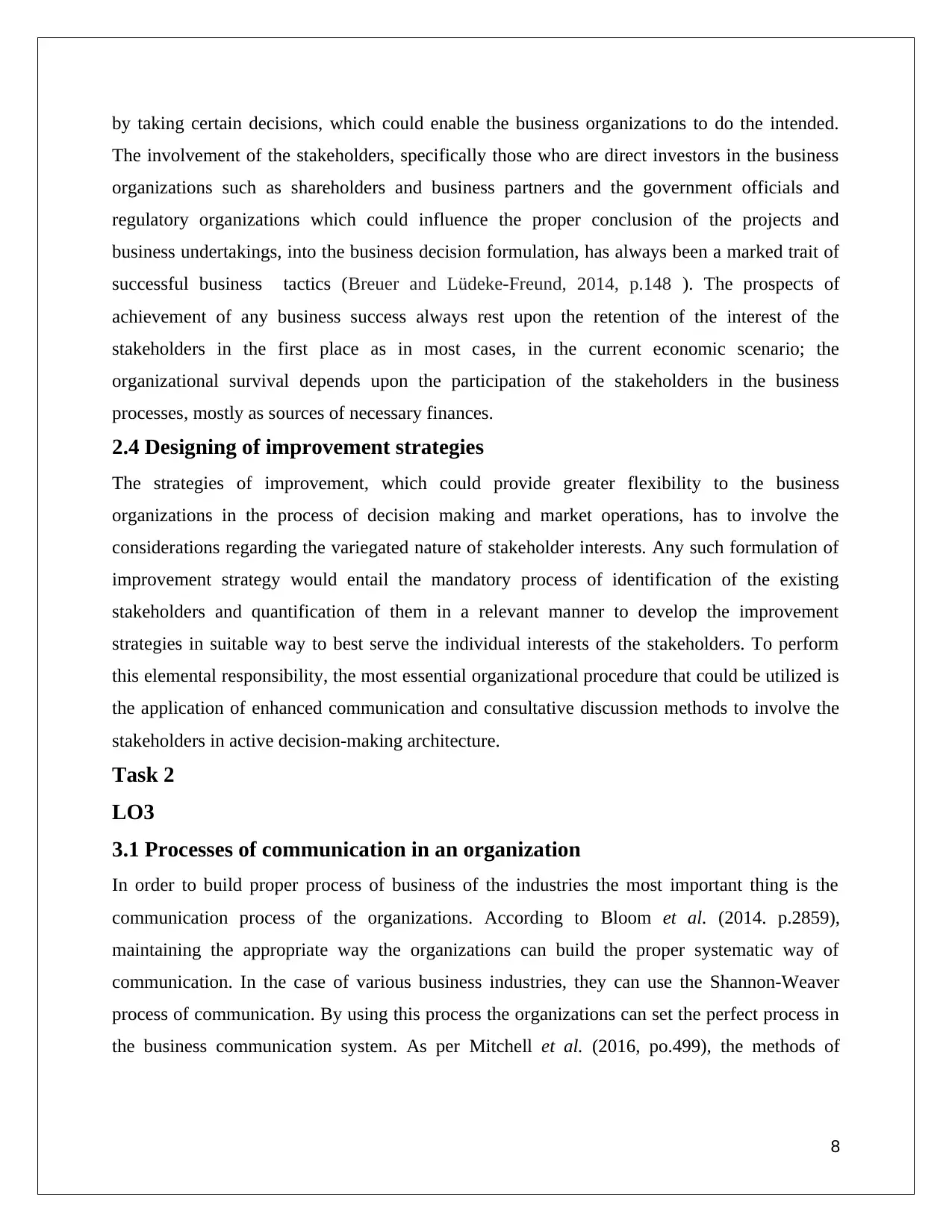
by taking certain decisions, which could enable the business organizations to do the intended.
The involvement of the stakeholders, specifically those who are direct investors in the business
organizations such as shareholders and business partners and the government officials and
regulatory organizations which could influence the proper conclusion of the projects and
business undertakings, into the business decision formulation, has always been a marked trait of
successful business tactics (Breuer and Lüdeke-Freund, 2014, p.148 ). The prospects of
achievement of any business success always rest upon the retention of the interest of the
stakeholders in the first place as in most cases, in the current economic scenario; the
organizational survival depends upon the participation of the stakeholders in the business
processes, mostly as sources of necessary finances.
2.4 Designing of improvement strategies
The strategies of improvement, which could provide greater flexibility to the business
organizations in the process of decision making and market operations, has to involve the
considerations regarding the variegated nature of stakeholder interests. Any such formulation of
improvement strategy would entail the mandatory process of identification of the existing
stakeholders and quantification of them in a relevant manner to develop the improvement
strategies in suitable way to best serve the individual interests of the stakeholders. To perform
this elemental responsibility, the most essential organizational procedure that could be utilized is
the application of enhanced communication and consultative discussion methods to involve the
stakeholders in active decision-making architecture.
Task 2
LO3
3.1 Processes of communication in an organization
In order to build proper process of business of the industries the most important thing is the
communication process of the organizations. According to Bloom et al. (2014. p.2859),
maintaining the appropriate way the organizations can build the proper systematic way of
communication. In the case of various business industries, they can use the Shannon-Weaver
process of communication. By using this process the organizations can set the perfect process in
the business communication system. As per Mitchell et al. (2016, po.499), the methods of
8
The involvement of the stakeholders, specifically those who are direct investors in the business
organizations such as shareholders and business partners and the government officials and
regulatory organizations which could influence the proper conclusion of the projects and
business undertakings, into the business decision formulation, has always been a marked trait of
successful business tactics (Breuer and Lüdeke-Freund, 2014, p.148 ). The prospects of
achievement of any business success always rest upon the retention of the interest of the
stakeholders in the first place as in most cases, in the current economic scenario; the
organizational survival depends upon the participation of the stakeholders in the business
processes, mostly as sources of necessary finances.
2.4 Designing of improvement strategies
The strategies of improvement, which could provide greater flexibility to the business
organizations in the process of decision making and market operations, has to involve the
considerations regarding the variegated nature of stakeholder interests. Any such formulation of
improvement strategy would entail the mandatory process of identification of the existing
stakeholders and quantification of them in a relevant manner to develop the improvement
strategies in suitable way to best serve the individual interests of the stakeholders. To perform
this elemental responsibility, the most essential organizational procedure that could be utilized is
the application of enhanced communication and consultative discussion methods to involve the
stakeholders in active decision-making architecture.
Task 2
LO3
3.1 Processes of communication in an organization
In order to build proper process of business of the industries the most important thing is the
communication process of the organizations. According to Bloom et al. (2014. p.2859),
maintaining the appropriate way the organizations can build the proper systematic way of
communication. In the case of various business industries, they can use the Shannon-Weaver
process of communication. By using this process the organizations can set the perfect process in
the business communication system. As per Mitchell et al. (2016, po.499), the methods of
8
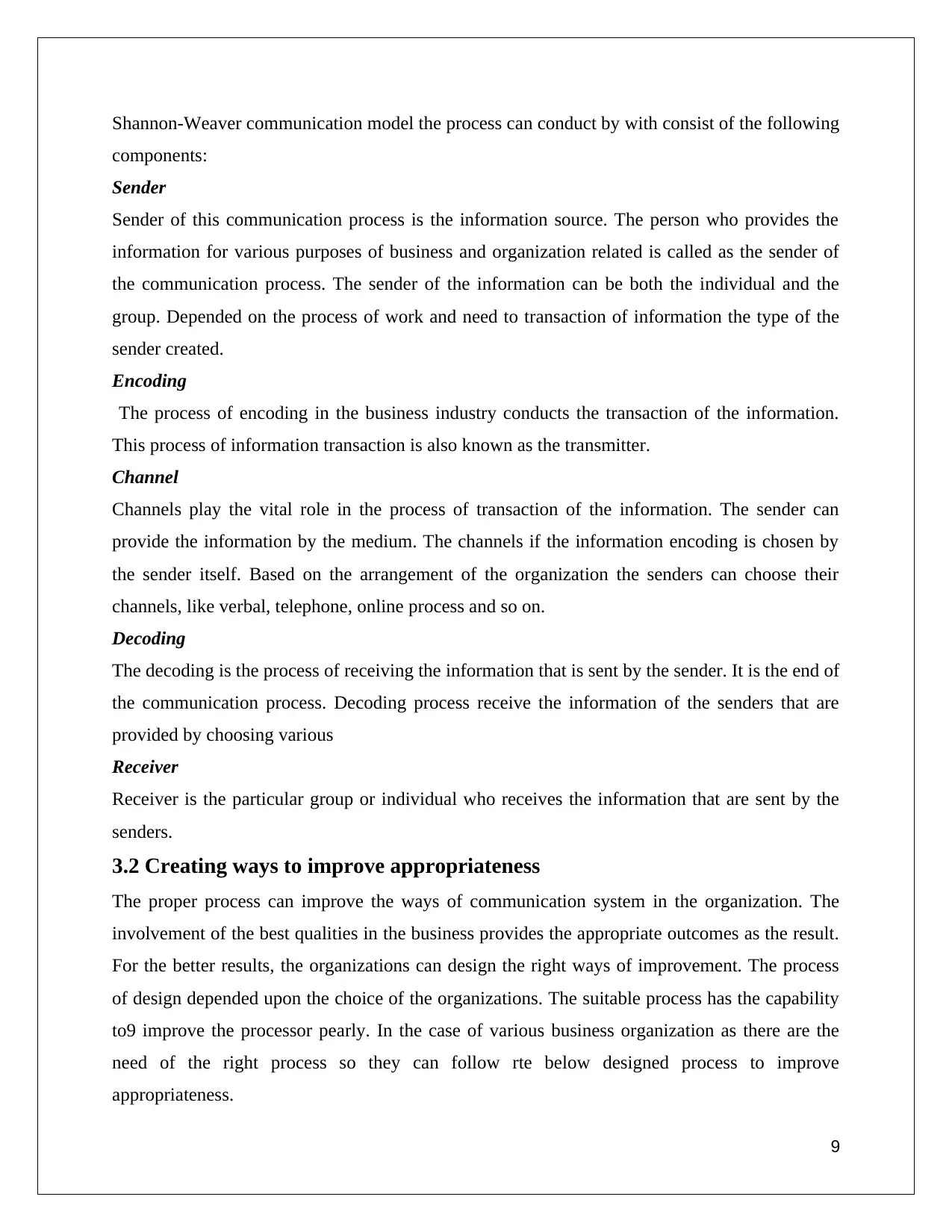
Shannon-Weaver communication model the process can conduct by with consist of the following
components:
Sender
Sender of this communication process is the information source. The person who provides the
information for various purposes of business and organization related is called as the sender of
the communication process. The sender of the information can be both the individual and the
group. Depended on the process of work and need to transaction of information the type of the
sender created.
Encoding
The process of encoding in the business industry conducts the transaction of the information.
This process of information transaction is also known as the transmitter.
Channel
Channels play the vital role in the process of transaction of the information. The sender can
provide the information by the medium. The channels if the information encoding is chosen by
the sender itself. Based on the arrangement of the organization the senders can choose their
channels, like verbal, telephone, online process and so on.
Decoding
The decoding is the process of receiving the information that is sent by the sender. It is the end of
the communication process. Decoding process receive the information of the senders that are
provided by choosing various
Receiver
Receiver is the particular group or individual who receives the information that are sent by the
senders.
3.2 Creating ways to improve appropriateness
The proper process can improve the ways of communication system in the organization. The
involvement of the best qualities in the business provides the appropriate outcomes as the result.
For the better results, the organizations can design the right ways of improvement. The process
of design depended upon the choice of the organizations. The suitable process has the capability
to9 improve the processor pearly. In the case of various business organization as there are the
need of the right process so they can follow rte below designed process to improve
appropriateness.
9
components:
Sender
Sender of this communication process is the information source. The person who provides the
information for various purposes of business and organization related is called as the sender of
the communication process. The sender of the information can be both the individual and the
group. Depended on the process of work and need to transaction of information the type of the
sender created.
Encoding
The process of encoding in the business industry conducts the transaction of the information.
This process of information transaction is also known as the transmitter.
Channel
Channels play the vital role in the process of transaction of the information. The sender can
provide the information by the medium. The channels if the information encoding is chosen by
the sender itself. Based on the arrangement of the organization the senders can choose their
channels, like verbal, telephone, online process and so on.
Decoding
The decoding is the process of receiving the information that is sent by the sender. It is the end of
the communication process. Decoding process receive the information of the senders that are
provided by choosing various
Receiver
Receiver is the particular group or individual who receives the information that are sent by the
senders.
3.2 Creating ways to improve appropriateness
The proper process can improve the ways of communication system in the organization. The
involvement of the best qualities in the business provides the appropriate outcomes as the result.
For the better results, the organizations can design the right ways of improvement. The process
of design depended upon the choice of the organizations. The suitable process has the capability
to9 improve the processor pearly. In the case of various business organization as there are the
need of the right process so they can follow rte below designed process to improve
appropriateness.
9
⊘ This is a preview!⊘
Do you want full access?
Subscribe today to unlock all pages.

Trusted by 1+ million students worldwide
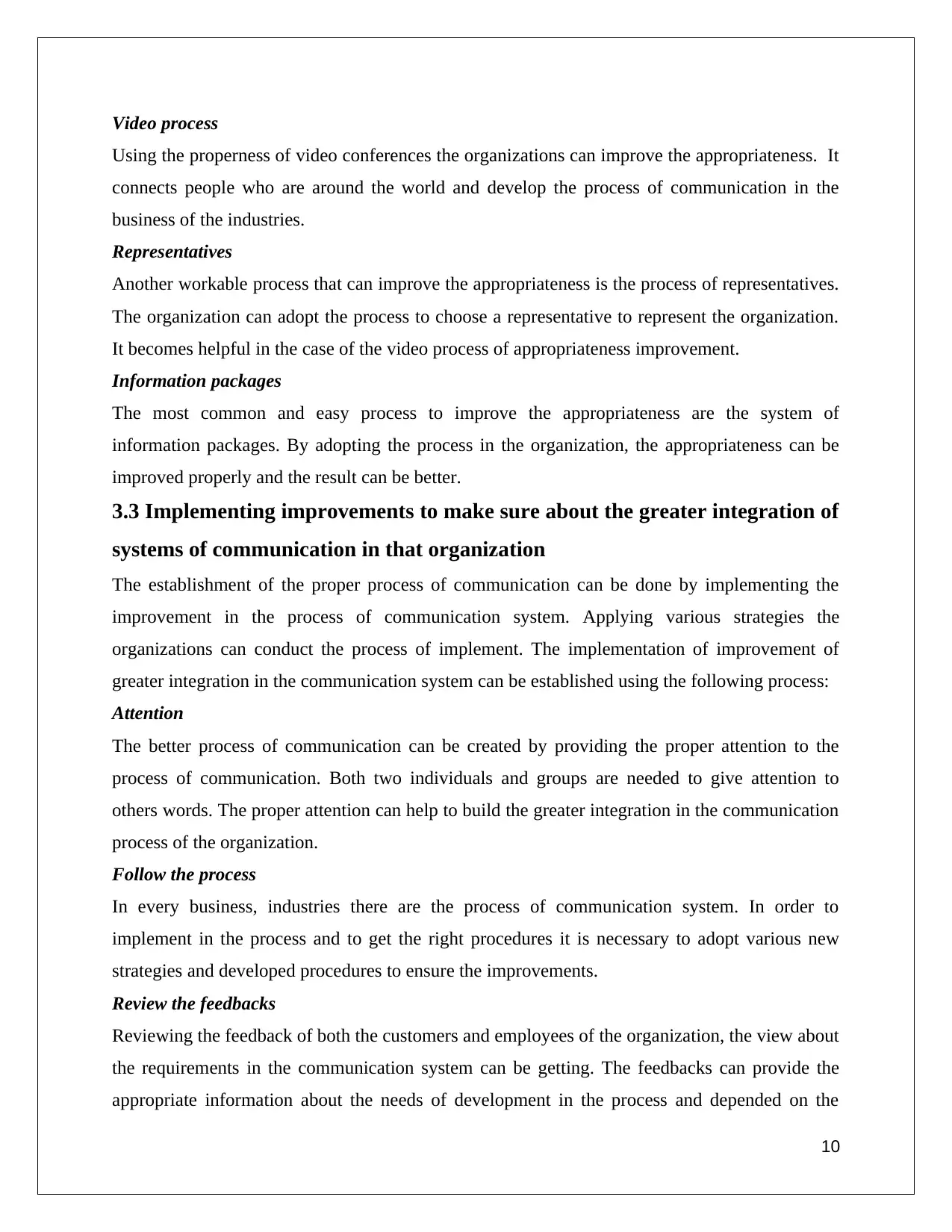
Video process
Using the properness of video conferences the organizations can improve the appropriateness. It
connects people who are around the world and develop the process of communication in the
business of the industries.
Representatives
Another workable process that can improve the appropriateness is the process of representatives.
The organization can adopt the process to choose a representative to represent the organization.
It becomes helpful in the case of the video process of appropriateness improvement.
Information packages
The most common and easy process to improve the appropriateness are the system of
information packages. By adopting the process in the organization, the appropriateness can be
improved properly and the result can be better.
3.3 Implementing improvements to make sure about the greater integration of
systems of communication in that organization
The establishment of the proper process of communication can be done by implementing the
improvement in the process of communication system. Applying various strategies the
organizations can conduct the process of implement. The implementation of improvement of
greater integration in the communication system can be established using the following process:
Attention
The better process of communication can be created by providing the proper attention to the
process of communication. Both two individuals and groups are needed to give attention to
others words. The proper attention can help to build the greater integration in the communication
process of the organization.
Follow the process
In every business, industries there are the process of communication system. In order to
implement in the process and to get the right procedures it is necessary to adopt various new
strategies and developed procedures to ensure the improvements.
Review the feedbacks
Reviewing the feedback of both the customers and employees of the organization, the view about
the requirements in the communication system can be getting. The feedbacks can provide the
appropriate information about the needs of development in the process and depended on the
10
Using the properness of video conferences the organizations can improve the appropriateness. It
connects people who are around the world and develop the process of communication in the
business of the industries.
Representatives
Another workable process that can improve the appropriateness is the process of representatives.
The organization can adopt the process to choose a representative to represent the organization.
It becomes helpful in the case of the video process of appropriateness improvement.
Information packages
The most common and easy process to improve the appropriateness are the system of
information packages. By adopting the process in the organization, the appropriateness can be
improved properly and the result can be better.
3.3 Implementing improvements to make sure about the greater integration of
systems of communication in that organization
The establishment of the proper process of communication can be done by implementing the
improvement in the process of communication system. Applying various strategies the
organizations can conduct the process of implement. The implementation of improvement of
greater integration in the communication system can be established using the following process:
Attention
The better process of communication can be created by providing the proper attention to the
process of communication. Both two individuals and groups are needed to give attention to
others words. The proper attention can help to build the greater integration in the communication
process of the organization.
Follow the process
In every business, industries there are the process of communication system. In order to
implement in the process and to get the right procedures it is necessary to adopt various new
strategies and developed procedures to ensure the improvements.
Review the feedbacks
Reviewing the feedback of both the customers and employees of the organization, the view about
the requirements in the communication system can be getting. The feedbacks can provide the
appropriate information about the needs of development in the process and depended on the
10
Paraphrase This Document
Need a fresh take? Get an instant paraphrase of this document with our AI Paraphraser
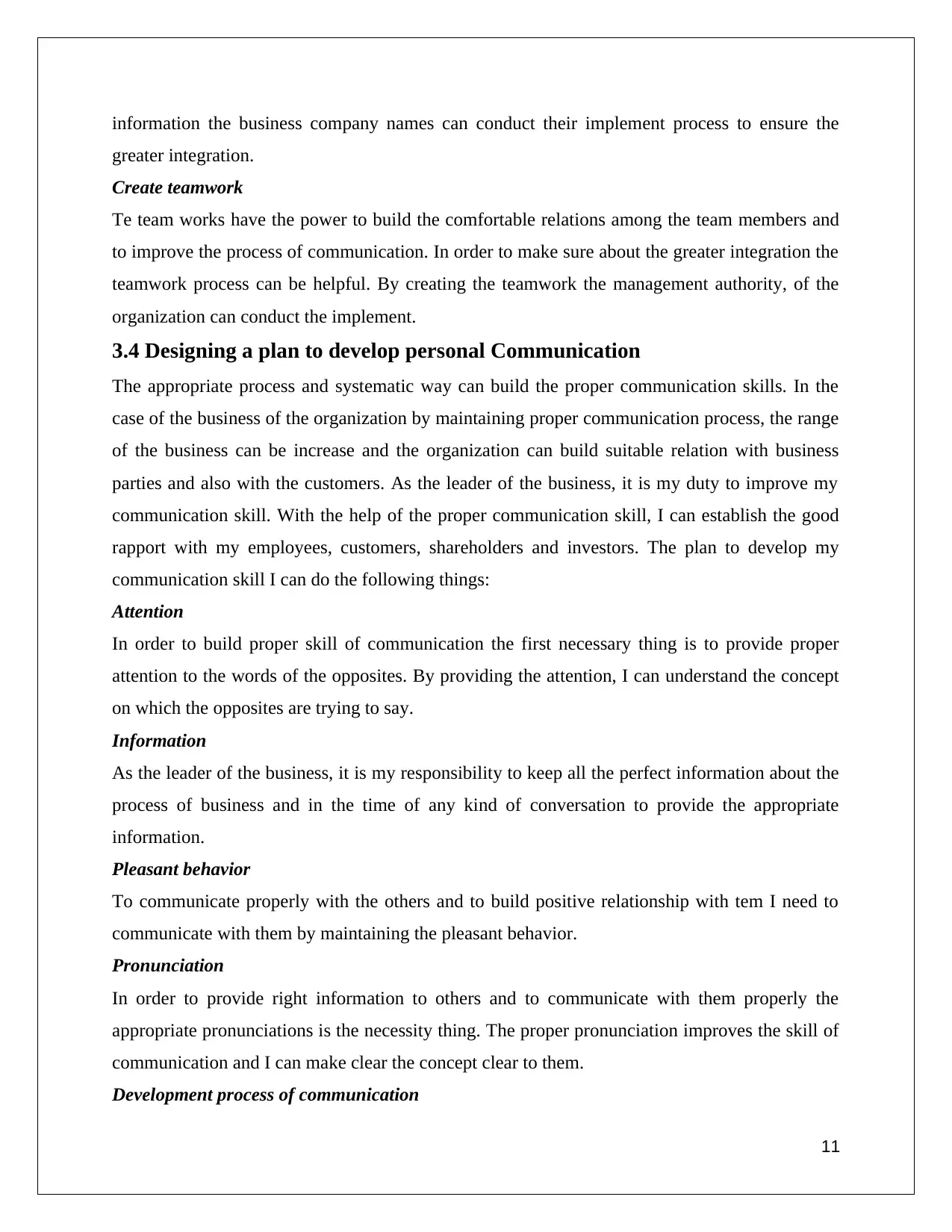
information the business company names can conduct their implement process to ensure the
greater integration.
Create teamwork
Te team works have the power to build the comfortable relations among the team members and
to improve the process of communication. In order to make sure about the greater integration the
teamwork process can be helpful. By creating the teamwork the management authority, of the
organization can conduct the implement.
3.4 Designing a plan to develop personal Communication
The appropriate process and systematic way can build the proper communication skills. In the
case of the business of the organization by maintaining proper communication process, the range
of the business can be increase and the organization can build suitable relation with business
parties and also with the customers. As the leader of the business, it is my duty to improve my
communication skill. With the help of the proper communication skill, I can establish the good
rapport with my employees, customers, shareholders and investors. The plan to develop my
communication skill I can do the following things:
Attention
In order to build proper skill of communication the first necessary thing is to provide proper
attention to the words of the opposites. By providing the attention, I can understand the concept
on which the opposites are trying to say.
Information
As the leader of the business, it is my responsibility to keep all the perfect information about the
process of business and in the time of any kind of conversation to provide the appropriate
information.
Pleasant behavior
To communicate properly with the others and to build positive relationship with tem I need to
communicate with them by maintaining the pleasant behavior.
Pronunciation
In order to provide right information to others and to communicate with them properly the
appropriate pronunciations is the necessity thing. The proper pronunciation improves the skill of
communication and I can make clear the concept clear to them.
Development process of communication
11
greater integration.
Create teamwork
Te team works have the power to build the comfortable relations among the team members and
to improve the process of communication. In order to make sure about the greater integration the
teamwork process can be helpful. By creating the teamwork the management authority, of the
organization can conduct the implement.
3.4 Designing a plan to develop personal Communication
The appropriate process and systematic way can build the proper communication skills. In the
case of the business of the organization by maintaining proper communication process, the range
of the business can be increase and the organization can build suitable relation with business
parties and also with the customers. As the leader of the business, it is my duty to improve my
communication skill. With the help of the proper communication skill, I can establish the good
rapport with my employees, customers, shareholders and investors. The plan to develop my
communication skill I can do the following things:
Attention
In order to build proper skill of communication the first necessary thing is to provide proper
attention to the words of the opposites. By providing the attention, I can understand the concept
on which the opposites are trying to say.
Information
As the leader of the business, it is my responsibility to keep all the perfect information about the
process of business and in the time of any kind of conversation to provide the appropriate
information.
Pleasant behavior
To communicate properly with the others and to build positive relationship with tem I need to
communicate with them by maintaining the pleasant behavior.
Pronunciation
In order to provide right information to others and to communicate with them properly the
appropriate pronunciations is the necessity thing. The proper pronunciation improves the skill of
communication and I can make clear the concept clear to them.
Development process of communication
11
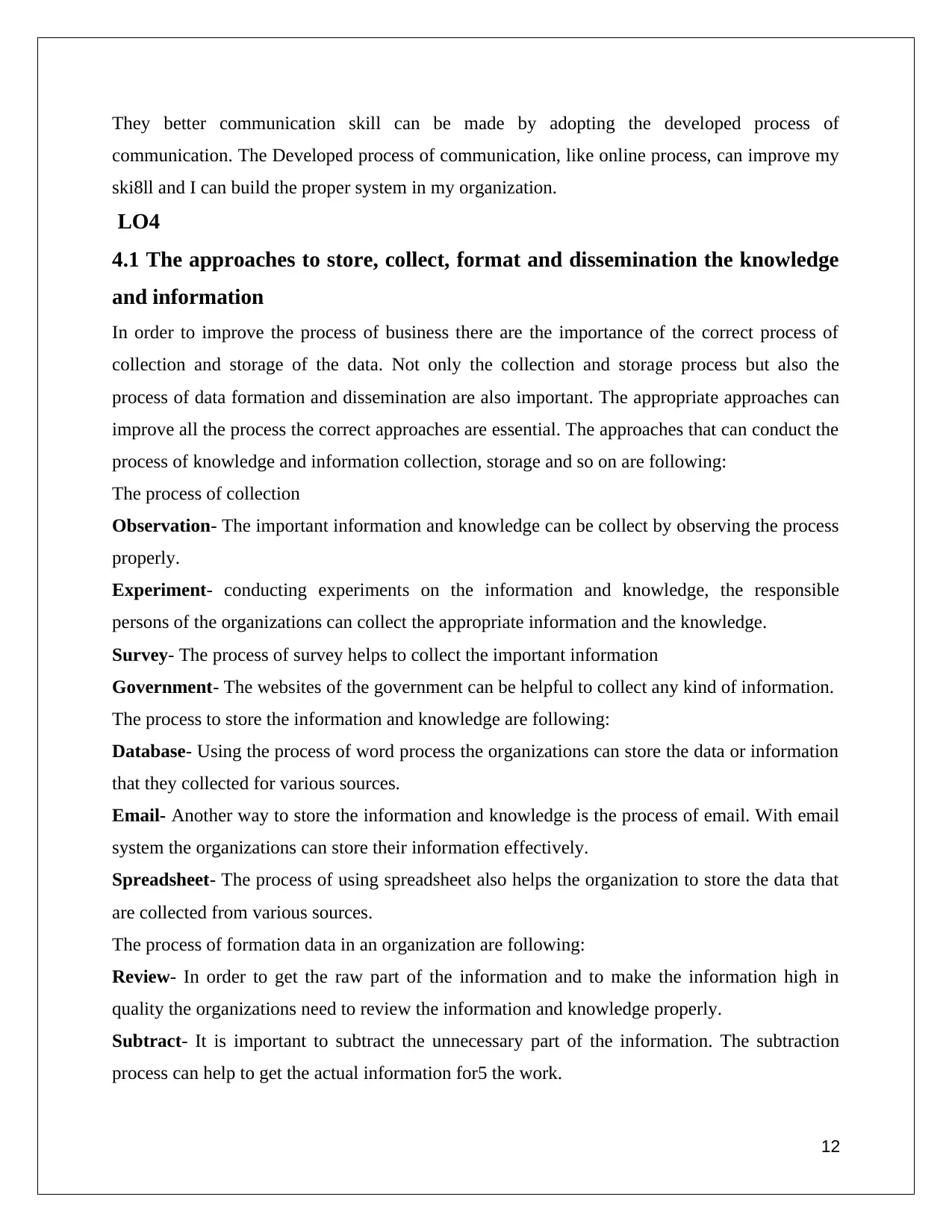
They better communication skill can be made by adopting the developed process of
communication. The Developed process of communication, like online process, can improve my
ski8ll and I can build the proper system in my organization.
LO4
4.1 The approaches to store, collect, format and dissemination the knowledge
and information
In order to improve the process of business there are the importance of the correct process of
collection and storage of the data. Not only the collection and storage process but also the
process of data formation and dissemination are also important. The appropriate approaches can
improve all the process the correct approaches are essential. The approaches that can conduct the
process of knowledge and information collection, storage and so on are following:
The process of collection
Observation- The important information and knowledge can be collect by observing the process
properly.
Experiment- conducting experiments on the information and knowledge, the responsible
persons of the organizations can collect the appropriate information and the knowledge.
Survey- The process of survey helps to collect the important information
Government- The websites of the government can be helpful to collect any kind of information.
The process to store the information and knowledge are following:
Database- Using the process of word process the organizations can store the data or information
that they collected for various sources.
Email- Another way to store the information and knowledge is the process of email. With email
system the organizations can store their information effectively.
Spreadsheet- The process of using spreadsheet also helps the organization to store the data that
are collected from various sources.
The process of formation data in an organization are following:
Review- In order to get the raw part of the information and to make the information high in
quality the organizations need to review the information and knowledge properly.
Subtract- It is important to subtract the unnecessary part of the information. The subtraction
process can help to get the actual information for5 the work.
12
communication. The Developed process of communication, like online process, can improve my
ski8ll and I can build the proper system in my organization.
LO4
4.1 The approaches to store, collect, format and dissemination the knowledge
and information
In order to improve the process of business there are the importance of the correct process of
collection and storage of the data. Not only the collection and storage process but also the
process of data formation and dissemination are also important. The appropriate approaches can
improve all the process the correct approaches are essential. The approaches that can conduct the
process of knowledge and information collection, storage and so on are following:
The process of collection
Observation- The important information and knowledge can be collect by observing the process
properly.
Experiment- conducting experiments on the information and knowledge, the responsible
persons of the organizations can collect the appropriate information and the knowledge.
Survey- The process of survey helps to collect the important information
Government- The websites of the government can be helpful to collect any kind of information.
The process to store the information and knowledge are following:
Database- Using the process of word process the organizations can store the data or information
that they collected for various sources.
Email- Another way to store the information and knowledge is the process of email. With email
system the organizations can store their information effectively.
Spreadsheet- The process of using spreadsheet also helps the organization to store the data that
are collected from various sources.
The process of formation data in an organization are following:
Review- In order to get the raw part of the information and to make the information high in
quality the organizations need to review the information and knowledge properly.
Subtract- It is important to subtract the unnecessary part of the information. The subtraction
process can help to get the actual information for5 the work.
12
⊘ This is a preview!⊘
Do you want full access?
Subscribe today to unlock all pages.

Trusted by 1+ million students worldwide
1 out of 17
Related Documents
Your All-in-One AI-Powered Toolkit for Academic Success.
+13062052269
info@desklib.com
Available 24*7 on WhatsApp / Email
![[object Object]](/_next/static/media/star-bottom.7253800d.svg)
Unlock your academic potential
Copyright © 2020–2025 A2Z Services. All Rights Reserved. Developed and managed by ZUCOL.





